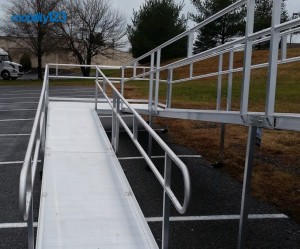Lower participation in worship by persons with disabilities is rarely caused by a lack of interest, but rather by barriers to participation that exist in architecture, communication or attitude. (Rife, Janet Miller, and Ginny Thornburgh. A Community Action Guide to Congregations and People with Disabilities. 2001.) Let’s face it, while most historic places of worship are beautifully built, they were not designed with accessibility in mind. Institutions with an aging membership are facing challenges providing safe entry and exit options that make worshipers feel comfortable and confident attending services. There are many affordable and safe solutions available today that can remove these barriers, and it is important that they are installed safely and comply with all state and local codes.
Choosing the right product plays a crucial role in improving accessibility to an institution. Space and budget constraints, as well as code restrictions may put limits on some solutions, so it is important to choose a provider who is an expert in the products they sell, and also the regulations that govern the installation of each of the products.
The most popular accessibility products on the market today are ramps, stairlifts and vertical platform lifts, and each one fulfills a very specific need. For example, modular and permanent ramps can provide safe wheelchair and walking access, but also can require a lot of space. One foot of ramp length is needed for every inch of rise, which can result in a 48-foot long ramp if 48 inches of rise is needed to reach an entrance or exit.

Stairlifts can provide an indoor or outdoor solution that, depending on the configuration, can be more affordable than a ramp, but they don’t provide wheelchair access. It is important to consider who needs access to your institution and whether or not it will meet the needs of the majority of users. Additionally, it is important to consider the width of the staircase when installing a stairlift, since it can limit egress which could violate a local fire code.


Vertical Platform Lifts or “VPLs” are a versatile solution that can provide full wheelchair access in confined spaces. VPLs can be enclosed or open, and can often be hidden from view so they won’t tarnish the look of a building. The cost to install a VPL also can vary significantly depending on the needs of a situation. A short, open VPL can be priced competitively with some curved stairlifts, while a fully enclosed VPL inside a shaft could cost double or triple that to. The most costly VPL however, , will typically still be more affordable than an elevator.


Whatever the best solution may be, don’t risk the liability of installing a non-compliant mobility product! Adhering to state and local codes is essential to providing a safe entry and exit solution for your visitors.
Mobility123 specializes in providing accessibility solutions for places of worship. We manage the entire permit process, including working with the State Department of Community Affairs and the local electric, fire and building code officials. Remember, installing a non-permitted elevator or accessibility device can make you subject to a shutdown of the equipment and fine of up to $500 per day. Choose an expert that you can trust!
Mobility123– Accessibility in Worship; Safe, Easy, Affordable.
Handicap access for churches, synagogues, and temples.


